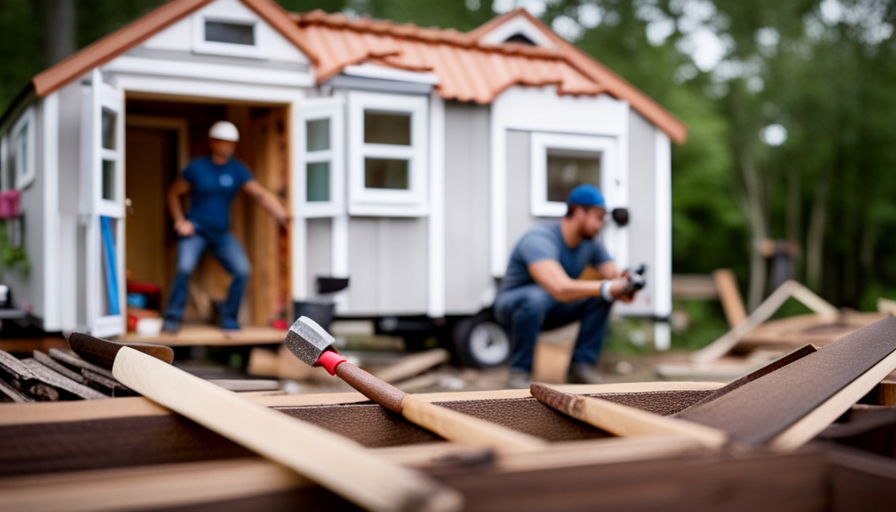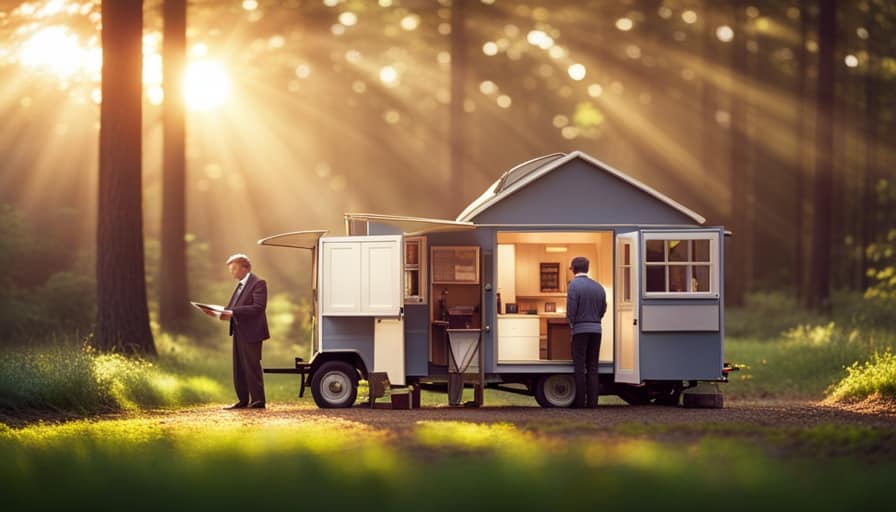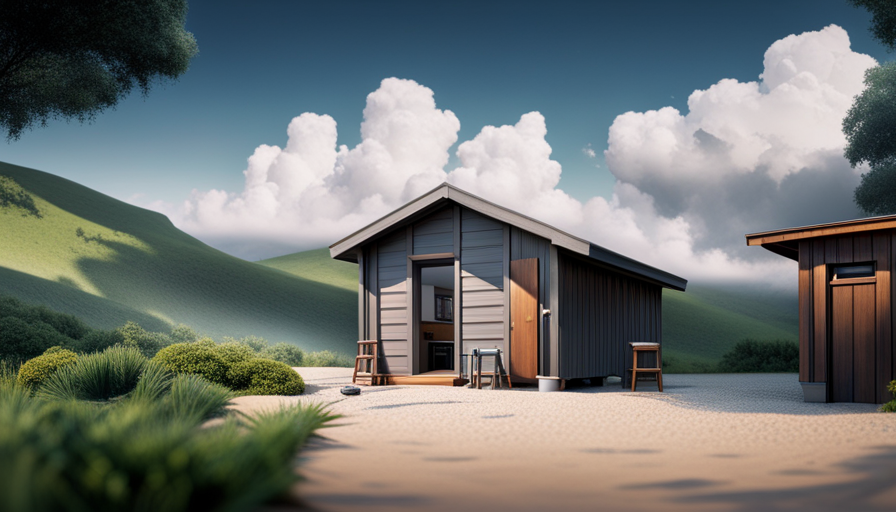Have you ever considered the possibility of building a small home without spending any money? I’m here to tell you that not only is it possible, but it can also bring a sense of pride and satisfaction.
In this article, I will share with you my practical tips and strategies for constructing your very own tiny house without spending a dime.
Now, you might be thinking, ‘How is this even possible?’ The truth is, it all starts with assessing your resources and skills. By taking stock of what you already have and what you can do, you can begin to plan your design and layout accordingly.
From there, it’s all about scavenging and repurposing materials, seeking help from friends and the community, and utilizing alternative building methods.
But building a tiny house with no money is not just about the physical aspects. It also requires embracing minimalism and simplicity, DIY-ing and learning new skills, and even trading or bartering for services and materials. And most importantly, it demands a positive and persistent mindset.
So, if you’re ready to embark on this incredible journey of building a tiny house without breaking the bank, let’s dive in and explore the possibilities together!
Key Takeaways
- Assess available resources and skills to determine what can be utilized in the construction process.
- Scavenge and repurpose materials from salvage yards, construction sites, and classified ads to minimize the need for expensive materials.
- Seek help from friends, the community, and tap into local resources for support, assistance, and unused or discarded materials.
- Embrace minimalism, DIY, and alternative building techniques to reduce costs and create a cost-effective build.
Assess Your Resources and Skills
Take a moment to evaluate what you’ve got and figure out how you can use your skills and resources to make your dream of a tiny house a reality, even if you don’t have any money. Assessing resources is the first step in building a tiny house with no money.
Look around your surroundings and identify what you already have available. Do you have access to land where you can build your tiny house? Are there any materials or tools that you can borrow or acquire for free?
Additionally, take stock of your skills and abilities. Can you do basic carpentry or plumbing? Are you a resourceful problem solver? Identifying strengths will help you determine what tasks you can handle on your own and what areas you may need assistance with.
Once you have assessed your resources and identified your strengths, it’s time to plan your design and layout. This step is crucial in making the most of your limited resources. Consider the size and layout of your tiny house. Are there any existing structures or materials that you can repurpose? Think creatively and make a detailed plan that maximizes the use of space and minimizes the need for expensive materials.
By carefully considering your resources and planning your design, you can start building your tiny house with no money.
Plan Your Design and Layout
Consider envisioning and mapping out the perfect arrangement and structure for your cozy, budget-friendly dwelling. When designing your tiny house with no money, there are a few design considerations to keep in mind.
Firstly, think about the size and layout that will work best for your needs. Take into account the available space you have and how you can optimize it to maximize functionality. Utilize multi-purpose furniture, such as storage beds or foldable tables, to make the most of every inch.
Another important aspect is the overall aesthetic and style of your tiny house. Determine the theme and color scheme that aligns with your personal taste and the atmosphere you want to create. This will help create a cohesive and visually appealing space.
Additionally, consider incorporating sustainable and eco-friendly features into your design. This can include using recycled or salvaged materials, implementing energy-efficient appliances, and utilizing natural lighting sources.
As you plan your design and layout, keep in mind that every decision you make should contribute to the overall goal of building a tiny house with no money. By carefully considering these design considerations and optimizing your space, you can create a practical and comfortable living environment without breaking the bank.
Moving forward, let’s explore how you can scavenge and repurpose materials to bring your vision to life.
Scavenge and Repurpose Materials
When it comes to building a tiny house with no money, one of the most important steps is to scavenge and repurpose materials. To find free or low-cost materials, I recommend exploring local salvage yards, construction sites, and classified ads.
These places often have materials that can be repurposed and upcycled to fit your design. It’s a practical way to save money and create a unique, sustainable home.
Explore local salvage yards, construction sites, and classified ads for free or low-cost materials
Scour local salvage yards, construction sites, and classified ads to find free or low-cost materials for your tiny house. This is a crucial step in building your tiny house with no money.
These places often have leftover materials from previous projects that can be repurposed for your own construction. Look for items like lumber, windows, doors, and even insulation. Not only will this help you save money, but it’ll also contribute to a more sustainable and eco-friendly build.
Get creative with your design solutions by thinking outside the box and utilizing materials in unconventional ways. For example, old shipping containers can be transformed into living spaces, and reclaimed wood can add a rustic charm to your interior.
By exploring these resources, you’ll be able to build your tiny house on a shoestring budget while also giving new life to materials that would’ve otherwise gone to waste.
Now, let’s move on to the next section and learn how to repurpose and upcycle materials to fit your design.
Learn how to repurpose and upcycle materials to fit your design
To truly make your tiny house unique, get creative and find ways to repurpose and upcycle materials that perfectly complement your design. Repurposing techniques allow you to give new life to old items, reducing waste and saving money.
For example, you can transform old wooden pallets into a beautiful feature wall or use reclaimed windows as unique accents in your design. Look for discarded materials such as doors, cabinets, or light fixtures that can be refurbished and integrated into your tiny house.
By repurposing and upcycling, you can add a personal touch to your home while also reducing your environmental impact. Design customization is key when building a tiny house, and repurposing materials allows you to create a space that reflects your individual style and needs.
Now, let’s explore how you can seek help from friends and the community to make your tiny house dream a reality.
Seek Help from Friends and Community
By reaching out to friends and community members, you can rally support and create a network of individuals willing to lend a hand in building your tiny house without spending any money. Community support is often invaluable when it comes to building a home from scratch, and you’ll be surprised at how many people are willing to help if you just ask.
Here are some ways to seek help from your community:
-
Organize a community work day: Gather your friends, family, and neighbors for a day of collective effort. By providing food and drinks, you can make it a fun and rewarding experience for everyone involved.
-
Utilize crowdfunding campaigns: Create an online crowdfunding campaign to raise funds for necessary materials and tools. This allows your friends and community members to contribute financially if they are unable to physically help with the construction.
-
Tap into local resources: Reach out to local businesses, organizations, and schools to see if they have any unused or discarded materials that you can repurpose for your tiny house. Many times, they’re happy to donate these items to a worthy cause.
By utilizing the power of community support and crowdfunding campaigns, you can gather the resources needed to build your tiny house without spending any money.
In the next section, we’ll explore alternative building methods that can further reduce costs and make your project more sustainable.
Utilize Alternative Building Methods
Utilizing alternative construction techniques can be a cost-effective approach to constructing a small dwelling without incurring significant expenses. When building a tiny house with no money, it’s crucial to explore alternative building methods that can help minimize costs.
One such method is using reclaimed materials. Many construction sites or demolition projects often have leftover materials that can be repurposed for building a tiny house. By salvaging these materials, you can reduce the need to purchase new ones, saving you a significant amount of money.
Another alternative building technique is utilizing natural and sustainable materials. This includes using materials such as straw bales, cob, or even earthbags. These materials are often readily available and can be obtained at little to no cost. Additionally, they’re eco-friendly and provide excellent insulation, reducing the need for additional heating or cooling systems.
Incorporating alternative energy sources is another way to cut down on expenses. By utilizing solar panels or wind turbines, you can generate your own electricity, eliminating the need to pay utility bills.
By tapping into government and nonprofit resources, you can access assistance programs that provide funding or low-cost materials for building projects. These resources can be instrumental in helping you construct your tiny house without relying solely on your own finances.
Tap into Government and Nonprofit Resources
When it comes to building a tiny house with little to no money, one important avenue to explore is tapping into government and nonprofit resources.
Start by investigating grants, loans, and programs that are available specifically for low-income housing or sustainable building projects. These resources can provide much-needed financial assistance and support.
Additionally, don’t hesitate to reach out to local nonprofits or organizations that are dedicated to supporting affordable housing initiatives. They may have valuable resources, connections, or advice to offer in your journey towards building a cost-effective tiny house.
Investigate grants, loans, and programs available for low-income housing or sustainable building projects
Explore the various grants, loans, and programs available for low-income housing or sustainable building projects to help you build your tiny house with no money. When it comes to grants for sustainable building, there are several options to consider. For instance, the Sustainable Energy Authority offers grants for renewable energy projects, which could help offset some of the costs associated with building a sustainable tiny house. In addition, there are loans specifically designed for low-income housing, such as the Low-Income Home Energy Assistance Program, which provides financial assistance to eligible individuals. Another option is to look into programs provided by organizations like Habitat for Humanity, which offer affordable housing solutions and may be able to assist with your tiny house project. By investigating these grants, loans, and programs, you can find the support you need to make your tiny house dream a reality. Next, reach out to local nonprofits or organizations that support affordable housing initiatives to further expand your resources.
Reach out to local nonprofits or organizations that support affordable housing initiatives
Don’t forget to tap into the vast network of local nonprofits or organizations that are just waiting to shower you with their support for your affordable housing initiatives. These organizations are dedicated to providing affordable housing solutions and promoting collaborative community efforts. Here are a few ways they can assist you:
-
Financial assistance: Many nonprofits offer grants or low-interest loans specifically for affordable housing projects.
-
Land acquisition: Some organizations may have access to land or can help you find suitable land for your tiny house.
-
Building materials: Nonprofits often have partnerships with suppliers or can assist in sourcing affordable or recycled materials.
-
Volunteer labor: Local organizations may have a network of volunteers who are willing to help with construction or other tasks.
By reaching out to these organizations, you can leverage their resources and expertise to make your tiny house project a reality.
Now, let’s delve into the next section and embrace minimalism and simplicity in our design.
Embrace Minimalism and Simplicity
To achieve a higher level of refinement in your construction process, consider embracing minimalism and simplicity when building a tiny house with limited funds. Embracing simplicity means downsizing your life and finding creative solutions to make the most of the space you have. It involves exploring alternative lifestyles and embracing sustainable living practices.
Adopting a minimalist mindset is crucial when building a tiny house with no money. It means living off the grid and finding joy in less. By practicing frugality and reducing your environmental impact, you can create a beautiful and functional tiny house without breaking the bank.
When it comes to designing your tiny house, keep in mind that less is more. Focus on essential elements and avoid unnecessary clutter. Use versatile furniture that can serve multiple purposes and maximize storage space. Incorporate natural light and choose materials that are durable and sustainable.
Additionally, think about alternative energy sources to power your tiny house. Solar panels and rainwater harvesting systems can help you live off the grid and reduce your reliance on traditional utilities.
By embracing minimalism and simplicity, you can create a tiny house that not only meets your basic needs but also provides a comfortable and fulfilling living space. Transitioning into the subsequent section about ‘diy and learn new skills,’ you can further enhance your construction process by acquiring new skills and knowledge.
DIY and Learn New Skills
Get your hands dirty and start learning new skills through DIY projects to enhance your construction process and create a unique living space. Building a tiny house with no money requires resourcefulness and a willingness to learn. Here are some ways to acquire new skills:
-
Attend DIY workshops: Many communities offer workshops where you can learn basic construction techniques and gain hands-on experience. These workshops often cover topics like framing, electrical work, and plumbing. Taking advantage of these opportunities will give you a solid foundation for your tiny house project.
-
Online tutorials: The internet is a treasure trove of information, and there are countless online tutorials that can teach you specific skills. From YouTube videos to blogs, you can find step-by-step instructions on everything from building a foundation to installing solar panels. Take advantage of these free resources to expand your knowledge.
-
Learn from others: Connect with experienced DIY builders and learn from their expertise. Join online forums or local tiny house communities to ask questions and get advice. Building a tiny house is a collaborative process, and learning from others can save you time and effort.
-
Start small: Begin with smaller DIY projects to build your confidence and skills. This could include building furniture, creating storage solutions, or even constructing a small shed. Starting small allows you to practice different techniques and gain the necessary skills before tackling the construction of your tiny house.
-
Experiment and problem solve: Building a tiny house with no money requires creativity and resourcefulness. Embrace the opportunity to experiment and problem-solve along the way. This mindset will not only help you save money but also enable you to create a truly unique living space.
By learning new skills through DIY projects, you can take control of your tiny house construction and create a home that reflects your personal style and needs. Once you’ve acquired these skills, you can begin to explore other avenues such as trade or barter for services and materials.
Trade or Barter for Services and Materials
When it comes to building a tiny house with no money, one option is to offer your own skills or services in exchange for construction assistance or materials. By reaching out to others in your community who have the necessary skills or resources, you can propose a mutually beneficial trade.
Another option is to explore bartering networks or online platforms where individuals are willing to trade resources. These platforms provide a great opportunity to connect with others who may have what you need and are open to trading for it.
Offer your skills or services in exchange for construction assistance or materials
Use your talents and expertise to barter for construction help or materials, creating a symbiotic relationship where everyone benefits from your valuable skills.
Creative solutions and community support are key when it comes to building a tiny house with no money. Offer your skills or services in exchange for construction assistance or materials. Maybe you’re a skilled carpenter, plumber, or electrician. Put your expertise to good use by offering your services to others in need of your particular skill set. In return, they can provide you with the necessary materials or lend a helping hand with the construction process.
Resource sharing and collaborative construction are at the heart of this approach, allowing you to build your tiny house without spending a dime. To connect with others willing to trade resources, explore bartering networks or online platforms. This way, you can find like-minded individuals who are also looking for a mutually beneficial exchange.
Explore bartering networks or online platforms to connect with others willing to trade resources
Check out bartering networks or online platforms to connect with fellow builders who are open to trading resources, allowing you to collaborate and exchange skills and materials for your dream home.
Here are some bartering alternatives and online trading platforms that can help you get started:
-
Freecycle: This online platform allows people to give away items they no longer need and find items they require for free.
-
TradeYa: This website facilitates trading of goods and services without the need for money.
-
Bunz: A popular app that enables users to trade items and services with others in their local community.
-
BarterQuest: This online platform allows you to trade goods, services, and even real estate with other users.
-
Letgo: A mobile app where you can sell or trade items locally.
By exploring these bartering networks and online platforms, you can find like-minded individuals willing to exchange resources for your tiny house project. Don’t forget to stay positive and persistent in your search for assistance and materials to make your dream a reality.
Stay Positive and Persistent
Maintaining a positive mindset and never giving up are key to successfully building a tiny house with limited funds. When faced with the challenges of building a tiny house with no money, it can be easy to get discouraged and lose motivation. However, by staying positive and persistent, you can overcome obstacles and achieve your goal of building a cozy and affordable home.
One way to maintain motivation is by setting small, achievable goals. Break down the building process into manageable tasks and celebrate each milestone you reach. This will not only give you a sense of accomplishment but also keep you motivated to continue.
It’s important to remember that building a tiny house with no money requires resourcefulness. Be open to creative solutions and don’t be afraid to ask for help. Reach out to friends, family, and your community for support. You might be surprised by the resources and assistance that’s available to you.
Another key to staying positive and persistent is to educate yourself about the process of building a tiny house. Research different construction methods, materials, and techniques. This knowledge will not only empower you but also help you overcome any obstacles that may arise.
Maintaining a positive mindset and never giving up are crucial when building a tiny house with limited funds. By staying motivated, overcoming obstacles, and being resourceful, you can successfully create your dream tiny home without breaking the bank.
Frequently Asked Questions
How can I assess my resources and skills to determine if I can build a tiny house with no money?
To determine if I can build a tiny house with no money, I need to assess my resources and skills.
First, I’ll evaluate the materials I have available, such as reclaimed wood or leftover construction materials.
Next, I’ll consider my skills in carpentry, plumbing, and electrical work. If I lack certain skills, I can explore options like watching online tutorials or seeking help from friends or local community organizations.
Lastly, I’ll create a budget by calculating any additional costs for materials or tools I may need.
What factors should I consider when planning the design and layout of my tiny house?
When planning the design and layout of a tiny house, several factors should be considered.
First and foremost, maximizing space is crucial. Utilize multi-functional furniture, such as loft beds with storage underneath. Incorporate clever storage solutions, like built-in shelves and hidden compartments.
Additionally, prioritize natural light to create an open and airy feel.
Finally, consider the flow and functionality of each room, ensuring that every square inch serves a purpose.
Are there any specific strategies or tips for finding and repurposing materials for my tiny house project?
When it comes to finding materials for your tiny house project on a tight budget, creative sourcing and repurposing hacks can be game-changers.
Start by exploring online classifieds, local buy/sell groups, and salvage yards for free or low-cost materials.
Additionally, consider reaching out to friends, family, and neighbors who might have unused or unwanted items that could be repurposed for construction.
Think outside the box and get creative with repurposing everyday items like pallets, shipping containers, and reclaimed wood for your tiny house construction.
How can I effectively seek help from friends and the community during the construction of my tiny house?
When it comes to seeking help from friends and the community during the construction of my tiny house, I’ve found that utilizing free resources is key. It’s amazing how many people are willing to lend a hand and offer their expertise.
From borrowing tools to sourcing materials, the community can be a treasure trove of support. Plus, it’s a great way to connect with like-minded individuals who share a passion for tiny living.
What are some alternative building methods that can be utilized when building a tiny house with no money?
When building a tiny house with no money, it’s crucial to explore alternative building methods and creative financing options.
One option is using salvaged materials, such as reclaimed wood or repurposed windows, which can be obtained for free or at a low cost.
Another alternative is to participate in a work-trade program, where you offer your skills or services in exchange for construction materials or assistance.
Additionally, crowdfunding platforms can help raise funds for your project.
Conclusion
So there you have it, folks! Building a tiny house with no money may seem like an impossible task, but with determination and resourcefulness, it can be done.
By assessing your resources and skills, planning your design, and utilizing alternative building methods, you can create a cozy and sustainable home without breaking the bank.
Don’t be afraid to scavenge and repurpose materials, seek help from friends and community, and embrace minimalism and simplicity.
With a DIY attitude and a positive mindset, you’ll be amazed at what you can achieve.
So go ahead, start building your dream tiny house today!
Hi, I’m Emma. I’m the Editor in Chief of Tiny House 43, a blog all about tiny houses. While tree houses are often associated with childhood, they can be the perfect adult retreat. They offer a cozy space to relax and unwind, surrounded by nature. And since they’re typically built on stilts or raised platforms, they offer stunning views that traditional homes simply can’t match. If you’re looking for a unique and romantic getaway, a tree house tiny house might just be the perfect option.










